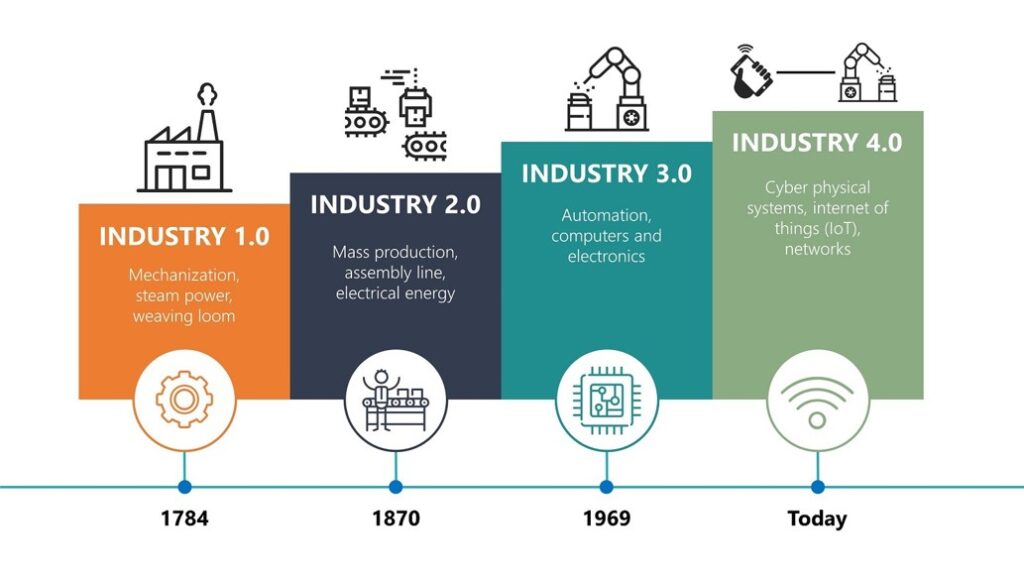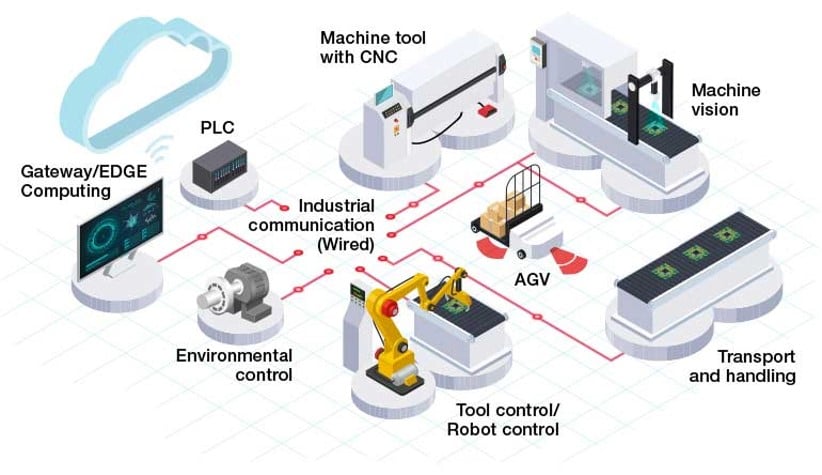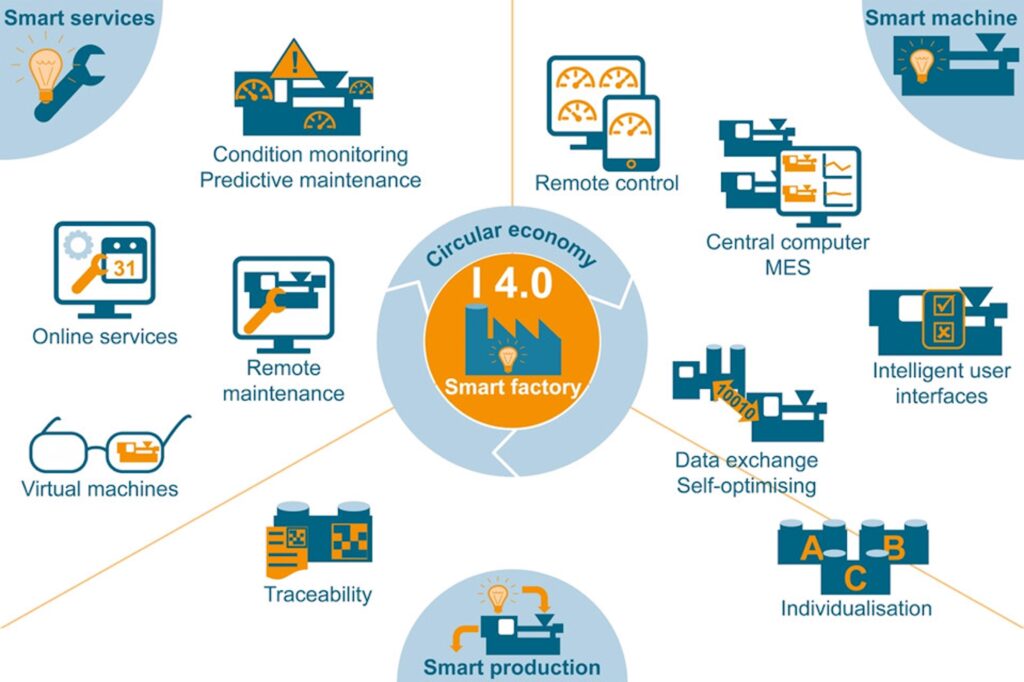Home » Security Bloggers Network » Industry 4.0 vs. Smart Factory: What Will the Future Look Like?
Industry 4.0 vs. Smart Factory: What Will the Future Look Like?
It isn’t easy to imagine the process that brings all our things into being. Just think about the journey your computer made from parts in a factory to the device you’re reading this article on today. We have the manufacturing process to thank for almost all our possessions. This process is long and intricate and has evolved dramatically over the last decades.
Before the advent of mechanized manufacturing processes, all manufactured tools had to be made by hand. However, the first significant changes to the manufacturing industry happened with the Industrial Revolution. This shift occurred in the 18th century when processes that previously required human labor began to be mechanized. Although replacing manual work with machinery was initially controversial, the revolution changed the way items are manufactured forever. Manufacturing quickly progressed from its early stages to mass production, and then to the adoption of IT systems and automation. These advancements have played a significant role in shaping our present-day world.
What Is Industry 4.0?
The third industrial revolution refers to the introduction of computers. Unlike the second industrial revolution, which upgraded existing technology to support mass production, the third revolution introduced entirely new technology. The fourth revolution promises to be more like the second, taking advantage of and optimizing computers by interconnecting them and giving them the ability to make manufacturing decisions independent of human involvement.
The “smart factory” is close to becoming a reality thanks to physically connected systems, the internet of things, and the internet of systems. As our machines gain access to more data, their ability to optimize factory processes will increase. Several organizations have already begun implementing Industry 4.0 and confirmed its positive impact. Computers can already automate many manufacturing processes, increasing speed and productivity. Additionally, having a network of interconnected machines track the manufacturing process makes identifying and resolving any quickly-occurring issues simpler. Predictive analytics can even make it possible to predict the problems before they happen based on patterns within the data.
Industry 4.0 Technologies
There is already a vast range of technologies included in Industry 4.0. Here are a few of the most relevant innovations and the role they play in the Fourth Industrial Revolution:
IoT
Internet of Things (IoT) is implemented into industrial processes. The interconnected network of devices is already a staple in most homes, and it’s now making its way into our factories. The Industrial Internet of Things (IIoT) involves building a communicating network of sensors and other smart devices directly on the manufacturing floor. Companies use this network of devices to collect data which can be used to drive AI processes and predictive analytics. IoT is likely to become one of the main pillars of Industry 4.0, with a recent Statista report indicating that 72% of respondents consider it the Industry 4.0 technology that will have the most significant effect on their organization.
Cloud Computing
With cloud computing, modern manufacturing can utilize data remotely, without the need for on-premises hardware or software. Manufacturing companies implement Industrial IoT software into their smart manufacturing set-up, to collect machine data and store it in cloud storage for later processing. This technology is continually being applied to more aspects of manufacturing. Unlike its predecessor technology that relies on individual devices, cloud computing is more reliable, scalable, and affordable due to not requiring in-house servers. It furthers the goal of Industry 4.0, giving smaller factories that lack the IT infrastructure to support smart manufacturing to utilize the advantages of cloud computing.
Manufacturers can use this technology for various applications, from product development to marketing. For example, the comprehensive information that cloud computing provides can give unique insights into marketing campaigns, making it easier to optimize and track the effectiveness of each campaign. Furthermore, by utilizing cloud computing, manufacturers are able to consolidate development and product planning data into a single stream. This accelerates the production process and enables products to reach completion at a faster pace.
Artificial Intelligence
A study by MIT revealed that approximately 60% of manufacturers have already implemented AI into their manufacturing process. AI reduces the need for downtime, increases productivity, and allows organizations to redirect human labor elsewhere. Manufacturing organizations are using AI to automate processes and gather insights that can be used to increase efficiency and even assist with maintenance by offering predictive solutions.
One of AI’s most practical applications in the manufacturing sector is quality assurance. AI technology can detect and analyze internal defects of manufacturing equipment more quickly and efficiently than the human eye. Human analysts easily overlook minor errors, while AI can detect malfunctions of all sizes.
Manufacturers can also use AI to predict equipment failure before it occurs. By observing equipment performance and analyzing data, AI technology can detect when a machine is not operating at peak functionality, preventing equipment shutdowns, manufacturing errors, and workplace accidents.
Big Data
Big Data comprises a large collection of information. This data can be collected from a huge number of endpoints and utilized for various projects, such as predictive analytics and machine learning projects. It is processed using tools that support Big Data analytics. Big data has a wide range of versatile applications within the manufacturing world. For example, big data makes it possible to predict supply chain needs and stay ahead of the game, reducing supply chain failure risk that typically leads to downtime. Like many other Industry 4.0 technologies, big data is already in use, and its market in manufacturing is continually growing. According to Fortune Business Insights, the global big data market in manufacturing is predicted to reach USD 9.11 billion by 2026, leading us into the age of Industry 4.0.
What Is a Smart Factory?
Manufacturers are embracing digitalization, with 81% of survey respondents saying that they believe digital technology has the potential to allow all manufacturers to create new markets. For many manufacturers, digitalization begins with smart factory technology. Smart factory describes applying various new technologies such as AI, big data, and IoT to fully streamline operations and create a flexible, self-adapting manufacturing process. In addition, smart factories are creating new avenues for optimization and heading toward fully optimized future manufacturing processes by connecting different functions and devices to collect new forms of information.
Relationship Between Industry 4.0 and Smart Factory
While Industry 4.0 and “smart factories” may sound like interchangeable terms, there are differences. Industry 4.0 is a broader term that refers to the fourth industrial revolution, which involves the integration of advanced technologies such as the Internet of Things (IoT), artificial intelligence (AI), and big data analytics into the manufacturing process. The goal of Industry 4.0 is to create a highly automated and connected manufacturing environment where machines, products, and people can communicate and collaborate in real-time.
Smart Factory, on the other hand, is a more specific concept that refers to a factory that utilizes Industry 4.0 technologies to optimize its manufacturing processes. A Smart Factory is a highly digitized and connected facility that leverages real-time data and analytics to improve productivity, efficiency, and quality. It uses advanced technologies like sensors, robotics, and AI to enable autonomous and self-optimizing production processes.
What Is the Future of Manufacturing and How Can Companies Adapt?
It may feel like Industry 4.0 has just appeared, technology moves fast, and Industry 5.0 is already on the horizon. Industry 5.0 aims to create a more human-centered approach that combines advanced technology with human creativity and collaboration.
The core idea behind Industry 5.0 is to create a manufacturing environment where humans and machines work together to achieve common goals. In this model, machines will take care of the repetitive and hazardous tasks while humans will focus on the more creative and complex aspects of production. Industry 5.0 also aims to prioritize sustainability, social responsibility, and the well-being of workers. It envisions a manufacturing environment that is not only efficient and productive but also environmentally friendly and socially responsible.
Moving forward automation and digitalization will continue to play a significant role in the future of manufacturing, and their potential applications are staggering. For example, the future will likely involve fully automated factories, which won’t even require lighting to accommodate human workers. Increasingly connected network evolutions, such as 5G technology, will also be crucial components of the next industrial revolution and transform the way we see manufacturing, as they offer significantly higher speeds, greater bandwidth, and lower latency than previous generations of cellular networks. This will enable manufacturers to connect and control a vast number of devices, machines, and sensors in real-time, making it possible to create highly flexible and responsive production processes.
Also, 5G technology can support the implementation of advanced technologies such as the Internet of Things (IoT), artificial intelligence (AI), and robotics, which can be used to create smart factories and enable autonomous and self-optimizing production processes, and it
can enable new forms of collaboration and communication between manufacturers, suppliers, and customers. For example, manufacturers can use augmented reality (AR) and virtual reality (VR) to provide remote support and training to workers, reducing the need for travel and on-site visits.
Overall, 5G technology will play a critical role in transforming the manufacturing industry by enabling greater connectivity, flexibility, efficiency, and responsiveness. It will enable manufacturers to create new products and services, improve their competitiveness, and adapt to the changing needs of customers and the market.
While these evolutions are exciting, the significant changes in our near future can also be intimidating. Adapting to digitalization and keeping up with quickly evolving technology is challenging, but innovative tools such as FirstPoint can help you adapt and adopt new technology ahead of the curve. A secure connectivity management solution doesn’t require any in-house software and is easy to integrate with existing technology. In addition, FirstPoint simplifies the complexity of managing large networks such as a web of IoT-connected devices, allowing you to extract data, identify issues early on, and keep a handle on an increasingly intricate series of operations.
Evolution Is Essential
Embracing new technologies early on gives you the advantage of quickly optimizing operations and adapting to new tech. It isn’t simple to keep up with the continually changing technological landscape, but it’s essential to keep up with competitors and general industry evolution. Connectivity management tools such as FirstPoint can help keep broad networks of interconnected devices manageable, allowing you to monitor your devices through a user-friendly interface effectively. These tools enable you to prevent system failures, assess performance analytics, and ensure that your network remains secure.
The post Industry 4.0 vs. Smart Factory: What Will the Future Look Like? appeared first on FirstPoint.
*** This is a Security Bloggers Network syndicated blog from Mobile & Cellular Cyber Security Blog Posts and Articles - FirstPoint authored by Aviv Bachar. Read the original post at: https://www.firstpoint-mg.com/blog/industry-4-0-vs-smart-factory-what-will-the-future-look-like/








